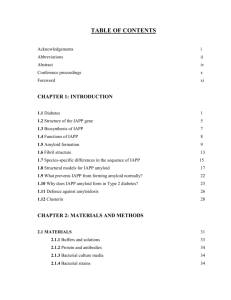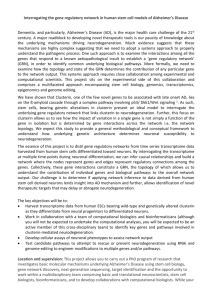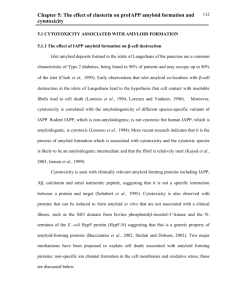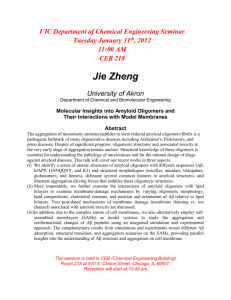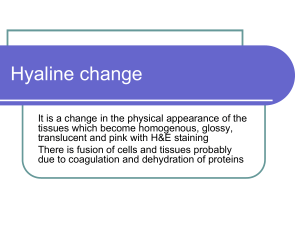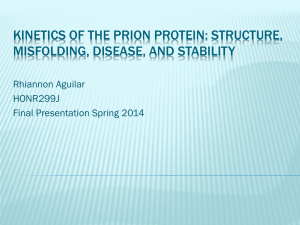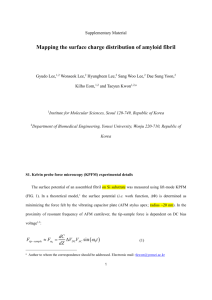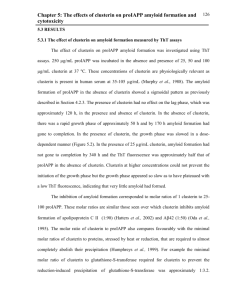ClusResno3FINISHed
advertisement
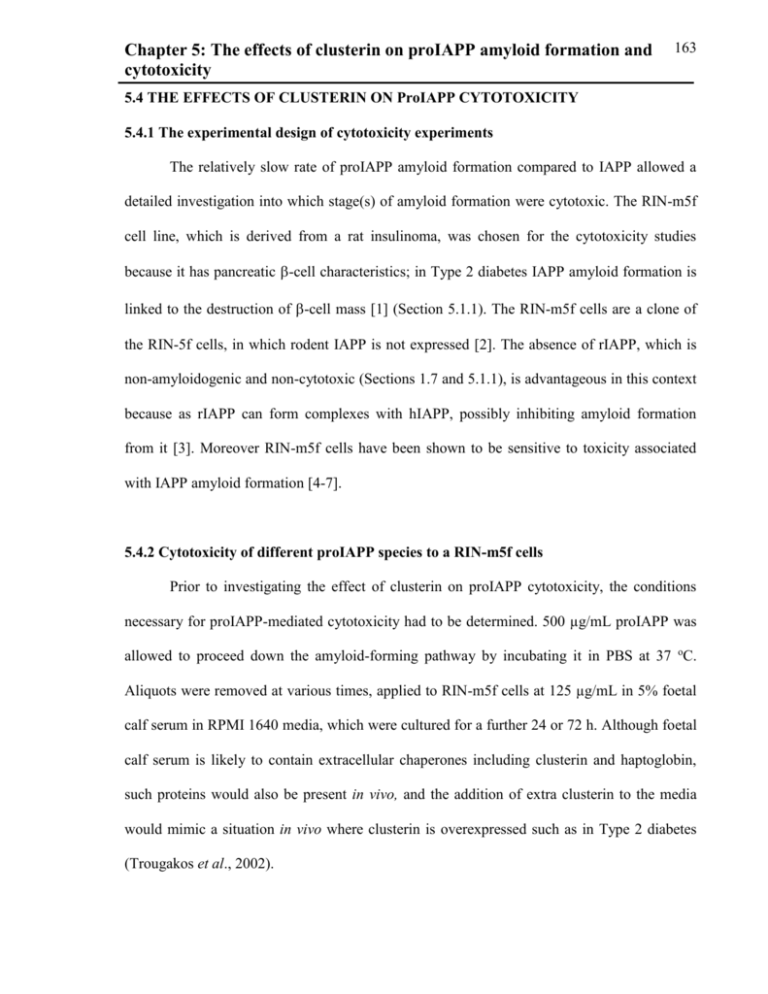
Chapter 5: The effects of clusterin on proIAPP amyloid formation and cytotoxicity 163 5.4 THE EFFECTS OF CLUSTERIN ON ProIAPP CYTOTOXICITY 5.4.1 The experimental design of cytotoxicity experiments The relatively slow rate of proIAPP amyloid formation compared to IAPP allowed a detailed investigation into which stage(s) of amyloid formation were cytotoxic. The RIN-m5f cell line, which is derived from a rat insulinoma, was chosen for the cytotoxicity studies because it has pancreatic -cell characteristics; in Type 2 diabetes IAPP amyloid formation is linked to the destruction of -cell mass [1] (Section 5.1.1). The RIN-m5f cells are a clone of the RIN-5f cells, in which rodent IAPP is not expressed [2]. The absence of rIAPP, which is non-amyloidogenic and non-cytotoxic (Sections 1.7 and 5.1.1), is advantageous in this context because as rIAPP can form complexes with hIAPP, possibly inhibiting amyloid formation from it [3]. Moreover RIN-m5f cells have been shown to be sensitive to toxicity associated with IAPP amyloid formation [4-7]. 5.4.2 Cytotoxicity of different proIAPP species to a RIN-m5f cells Prior to investigating the effect of clusterin on proIAPP cytotoxicity, the conditions necessary for proIAPP-mediated cytotoxicity had to be determined. 500 µg/mL proIAPP was allowed to proceed down the amyloid-forming pathway by incubating it in PBS at 37 oC. Aliquots were removed at various times, applied to RIN-m5f cells at 125 µg/mL in 5% foetal calf serum in RPMI 1640 media, which were cultured for a further 24 or 72 h. Although foetal calf serum is likely to contain extracellular chaperones including clusterin and haptoglobin, such proteins would also be present in vivo, and the addition of extra clusterin to the media would mimic a situation in vivo where clusterin is overexpressed such as in Type 2 diabetes (Trougakos et al., 2002). Chapter 5: The effects of clusterin on proIAPP amyloid formation and cytotoxicity 164 To avoid confusion about the two types of incubation time, the proIAPP incubation time prior to addition to cells will be referred to below as the “aging time” and the proIAPP incubation time with cells will be referred as the “culture time”. The stage of amyloid formation was monitored by ThT assays (Figure 5.19A). An assay based on the reduction of 3(4,5-dimethylthiazol-2-yl)-5-(3-carboxymethoxyphenyl)-2-(4-sulfophenyl)-2H-tetrazolium (MTS) was used to measure the numbers of cells after treatment with proIAPP and this was compared to cells that had received PBS as a vehicle control. Viable cells are able to reduce MTS to formazan, which is quantified by the absorbance at 490 nm. ProIAPP taken during the lag phase of amyloid formation was not toxic to cells at 125 µg/mL with a culture time of 48 h but with a culture time of 72 h the numbers of viable cells was reduced to approximately 80% (Figure 5.19B). ProIAPP aged for 48 h, which corresponds to the initiation of the amyloid growth phase, was cytotoxic and the number of viable cells was reduced to approximately 70% with a culture time of 72 h compared to the PBS control. ProIAPP fibrils were not toxic (Figure 5.19, 96 h). This indicates that the cytotoxicity of proIAPP was dependent on both the stage of proIAPP amyloid formation before being applied to the cells and the duration of the culture time. ProIAPP became more cytotoxic during the lag phase of amyloid formation as it progresses down the amyloid-forming pathway and appeared to be most toxic at the initiation of the growth phase. ProIAPP becomes progressively less cytotoxic as fibrils form and once amyloid formation has gone to completion, proIAPP was no longer cytotoxic. This is consistent with the idea that oligomers are the cytotoxic species, these would increase in concentration during the lag phase and then decrease during the growth phase as they are replaced by mature fibrils. 165 Chapter 5: The effects of clusterin on proIAPP amyloid formation and cytotoxicity A B 140 700 120 600 100 % number of cells ThT fluorescence (AU) 800 500 400 300 ^ ^ ^ ^ ^ * 80 * 60 40 200 20 100 0 0 0 20 40 60 80 100 0 Aging time (h) 24 48 72 96 Aging time (h) Figure 5.19 ProIAPP cytotoxicity is dependent on the stage of amyloid formation. 500 µg/mL proIAPP was incubated in PBS at 37 oC and amyloid formation was monitored by ThT assay (A) as described in figure 4.4.1. ProIAPP was diluted into 5% FCS, RPMI 1640 and applied to cells at 125 µg/mL. Cells were cultured for a further 48 h (red bars) or 72 h (blue bars) and cells numbers were measured by CellTiter 96® AQueous Non-Radioactive Cell Proliferation Assay (Promega) (B) as described in Section 2.2.28. The numbers of cells in wells that had received proIAPP were compared to cells that had received PBS as a vehicle control. The data shown are means ± standard deviations of triplicate measurements. 5.4.3 The concentration-dependence of proIAPP cytotoxicity The concentration-dependence of proIAPP cytotoxicity was investigated in similar experiments to that described in Section 5.4.2, except that proIAPP was aged at 1 mg/mL in PBS to allow up to 250 µg/mL to be subsequently added to the RIN-m5f cells. In addition the numbers of cells was quantified using CellTiter-BlueTM Cell Viability Assay (Promega) the MTS assay in Section 5.4.2. The basis of the assay is the cellular reduction of resazurin to the fluorescent resorufin. The resorufin was quantified by measuring the fluorescence at 590 nm Chapter 5: The effects of clusterin on proIAPP amyloid formation and cytotoxicity 166 with an excitation wavelength of 560 nm. Although CellTiter-BlueTM and MTS both measure cell viability through the reduction of a substrate, the advantage of the CellTiter-BlueTM assay is that fluorescence rather than absorbance is measured, resulting in an increased signal to noise ratio. The culture medium contributes to the absorbance measured in the MTS assay but there is a negligible contribution to the fluorescence in the CellTiter-BlueTM assay. A 600 ThT fluorescence (AU) 500 400 300 200 100 0 0 20 40 60 80 100 120 Aging time (h) C: 120 h 120 120 100 100 % number of cells % number of cells B: 0 h 80 60 40 20 0 -50 80 60 40 20 0 50 100 150 200 250 Concentration of proIAPP (µg/mL) 300 0 -50 0 50 100 150 200 250 300 Concentration of proIAPP (µg/mL) Figure 5.20 Concentration-dependence of proIAPP cytotoxicity. 1 mg/mL proIAPP was incubated in PBS at 37 oC and amyloid formation was measured by ThT assay as described in figure (A). ProIAPP at 0 h (B) or fibrillar proIAPP at 120 h (C) were applied to RIN-m5f cells and the cells were cultured for 48 h (red) or 72 h (blue). The numbers of cells were measured using CellTiter-BlueTM Cell Viability Assay (Promega) as described in Section 2.2.29. The data shown are means ± standard deviations of triplicate measurements. Chapter 5: The effects of clusterin on proIAPP amyloid formation and cytotoxicity 167 Consistent with previous findings (Section 5.4.2), soluble proIAPP was more cytotoxic than fibrillar proIAPP. Soluble proIAPP was cytotoxic in a dose-dependent manner. The highest concentration tested, 250 µg/mL proIAPP, was extremely toxic and after a culture time of 72 h there was less than 20% viable cells compared to cells that had received PBS only (Figure 5.20B). 15.6 µg/mL fibrillar proIAPP, the lowest concentration tested, added to cells and cultured for 48 h resulted in 85 6% viable cells compared to the cells that had received PBS only. Higher concentrations of fibrillar proIAPP did not reduce cell numbers further nor did increasing the culture time to 72 h. These findings imply that fibrillar proIAP was not cytotoxic (Figure 5.20C). This is consistent with the cytotoxicity results of Krampert et al. for fibrillar proIAPP [6]. In these experiments, fibrillar proIAPP was added to RIN-m5f cells at concentrations up to 1 µM (7.5 µg/mL). 82 8% cells were viable after being cultured in the presence of 1 µM proIAPP for 20 h [6]. Krampert et al. found that fibrillar proIAPP was less cytotoxic than fibrillar IAPP under the same conditions. 1 µM fibrillar IAPP (expressed as IAPP monomer), after being cultured with RIN-m5f cells for 20 h, halved the cell viability. Our cytotoxicity data for 250 µg/mL proIAPP (Figure 5.21, red bars) indicates that proIAPP species preceding mature fibrils are more cytotoxic than fibrillar proIAPP. RIN-m5f cells cultured for 48 h in the presence of 250 µg/mL (32 µM) proIAPP, which had been aged for 48 h, decreased the numbers of cells to 40% compared to controls (Figure 5.21, A, 48 h, red bars). An examination of the literature shows that different cytotoxicity studies give different IAPP concentrations that are cytotoxic. Freshly dissolved 10 µM IAPP added to RIN-m5f cells and cultured for 24 h, reduced cell viability to 50% compared to controls in one study [7] but did not cause toxicity in another study [4]. In the Janciaukiene et al. study 10 µM IAPP aged for 5 Chapter 5: The effects of clusterin on proIAPP amyloid formation and cytotoxicity 168 days was found to cytotoxic and reduced cell viability to 30% after a culture time of 24 h [4]. In another study using RIN cells, the cell line from which RIN-m5f was derived, 20 µM freshly dissolved IAPP was not cytotoxic but 40 µM IAPP decreased cell numbers to 50% after being cultured for 20 h [9]. These differences may be due to different preparations of IAPP containing different proportions of monomer, amyloidogenic intermediates and mature fibrils and variable rates of amyloid formation. Nonetheless, in comparison to IAPP, 250 µg/mL (32 µM) proIAPP in its most cytotoxic form (aged for 48 h) reduced the numbers of cells to 40% compared to controls after a culture time of 48 h, approximately double that required for IAPP, suggesting that proIAPP may be less cytotoxic than IAPP. 5.4.4 The effect of clusterin on proIAPP cytotoxicity The effect of clusterin on proIAPP cytotoxicity was measured in two types of time course experiments. In the first series of experiments, proIAPP was aged in the absence of clusterin. ProIAPP of different “ages” was then added to cells in the presence of varying concentrations of clusterin. The purpose of these experiments was to assess the effect of clusterin, at concentrations comparable to that present in human serum [10], on different proIAPP species present during amyloid formation. In the second series of experiments, mixtures of proIAPP in the presence of varying concentrations of up to 100 µg/mL clusterin were aged and then added to cells (Section 5.4.5). Once these mixtures of proIAPP aged in the presence of clusterin were diluted into cell culture medium and applied to cells, the concentration of clusterin was below the concentrations normally present in serum. The purpose of the second experiment was to see if proIAPP co-incubated with clusterin lead to the build-up of toxic intermediates and enhanced the toxicity, as has been suggested for A[11,12] Chapter 5: The effects of clusterin on proIAPP amyloid formation and cytotoxicity 169 ProIAPP in the first series of experiments was aged by the incubation of 1 mg/mL proIAPP in the absence of clusterin in PBS at 37 oC. The amount of amyloid was measured by ThT assays (Figure 5.20A). ProIAPP was diluted to 250 µg/mL in cell culture medium and added to RIN-m5f cells in the presence of varying concentrations of clusterin up to 100 µg/mL. 100 µg/mL clusterin in the absence of proIAPP was also added to the cells as a control to see if clusterin alone affects the cell viability of RIN-m5f cells. Cells were cultured for a further 72 h and the cell viability measured as described in Section 2.2.30. 120 * ^ * 100 # * ^ % numbers of cells * # 80 # # 60 ^ * ^ # # # * 40 20 0 0 24 48 72 96 120 Aging time (h) Figure 5.21 The effect of clusterin on the cytotoxicity of proIAPP at different stages of amyloid formation. ProIAPP was taken at different stages of amyloid formation (figure 4.4.19) and diluted to 250 µg/mL in 5% FCS, RPMI 1640 and added to RIN-m5f cells in the absence of clusterin (red bars) or in the presence of 25 µg/mL (blue bars), 50 µg/mL (green bars), 100 µg/mL (black bars). 100 µg/mL clusterin was added to RIN-m5f cells in the absence of proIAPP (orange bars). The cells were cultured for a further 72 h. The numbers of cells were measured using CellTiter-BlueTM Cell Viability Assay (Promega) as described in Section 2.2.29. The number of cells in wells that had received the proIAPP was compared to cells that had received PBS as a vehicle control. The data shown are means ± standard deviations of triplicate measurements. The significance of the presence of clusterin compared to the absence of clusterin was assessed using Student’s t-test (^ p < 0.05, * p < 0.005, # p < 0.0005). In these experiments proIAPP at 250 µg/mL showed a pattern of toxicity (Figure 5.21) that was dependent on the stage of amyloid formation, similar to that seen with 125 µg/mL proIAPP (Figure 5.19B). The proIAPP was most cytotoxic after being aged for 24 h, which Chapter 5: The effects of clusterin on proIAPP amyloid formation and cytotoxicity 170 corresponded to the start of the growth phase of amyloid formation (Figure 5.21). The presence of clusterin reduced proIAPP cytotoxicity in a dose dependent manner at every stage of amyloid formation. ProIAPP aged for 24 h, which was the most cytotoxic, and cultured with cells for 72 h, resulted in a decrease in the numbers of viable cells to less than 10% compared to the PBS vehicle control, however in the presence of 100 µg/mL clusterin there were 70% viable cells (Figure 5.21). Clusterin alone added to the cells did not cause any change in the number of cells (Figure 5.21), therefore the reduction in cytotoxicity is likely to be due to an interaction between clusterin and proIAPP. 5.4.5 The cytotoxicity of proIAPP species formed in the presence of clusterin Soluble amyloid precursors rather than mature fibrils are believed to be responsible for cytotoxicity (Section 5.1.1). The data presented above and in Section 5.4.2, showing that proIAPP is most cytotoxic during the start of the growth phase of amyloid formation, a stage likely to contain the highest concentration of amyloidogenic precursors, supports this idea. Clusterin inhibits amyloid formation and this may result in a build-up of soluble precursors, which are more cytotoxic. Therefore mixtures of proIAPP in the presence of various concentrations of clusterin were aged and then added to cells to assess this possibility. The inhibition of amyloid formation was monitored by ThT assay (Figure 5.22A). Clusterin inhibited amyloid formation in a dose-dependent manner, consistent with previous findings (Figure 5.2 and 5.13). Mixtures of 750 µg/mL proIAPP incubated in the presence of various concentrations of clusterin of up to 100 µg/mL were diluted into cell culture medium and added to cells to give 187.5 µg/mL proIAPP and concentrations of up to 25 µg/mL clusterin. The cells were cultured in the presence of proIAPP and clusterin for a further 72 h and the cell viability was measured using the CellTiter-BlueTM Cell Viability Assay. For simplicity, the concentrations Chapter 5: The effects of clusterin on proIAPP amyloid formation and cytotoxicity 171 of proIAPP and clusterin referred to below are the final concentrations in the cell culture medium. The equivalent values in the incubation stage of the experiment are 4 times those quoted below. During the lag phase of amyloid formation, clusterin reduced proIAPP toxicity in a dose-dependent manner. At an aging time of 72 h, which corresponded to the start of the growth phase, proIAPP alone was the most cytotoxic, reducing the numbers of viable cells to approximately 50% compared to controls (Figure 5.22B). At an aging time of 72 h, clusterin was cytoprotective in a dose-dependent manner, with the cell viability ranging from 70% to 85% in the presence of 6 µg/mL clusterin to 25 µg/mL clusterin, respectively. At an aging time of 96 h, the presence of 6 µg/mL clusterin significantly increased the cytotoxicity (p < 0.05) compared to proIAPP alone and may be an anomaly (Figure 5.22B). Nonetheless this result does not support the notion that suppression of amyloid formation by clusterin enhances the toxicity of proIAPP as 6 µg/mL clusterin does not inhibit amyloid formation (Figure 5.22A). In the presence of higher clusterin concentrations, 13 and 25 µg/mL the proIAPP toxicity was no different to proIAPP alone. If the suppression of amyloid formation by clusterin did enhance proIAPP toxicity, one would expect that the proIAPP species formed by co-incubations with 13 and 25 µg/mL clusterin should be more cytotoxic than proIAPP and 6 µg/mL clusterin, contrary to what was observed. Chapter 5: The effects of clusterin on proIAPP amyloid formation and cytotoxicity 172 A 1200 ThT fluorescence (AU) 1000 800 600 400 200 0 0 24 48 B 72 96 120 144 168 192 Aging time (h) 140 120 ^ % numbers of cells 100 ^^^ ^ #* ^ * 80 ^ 60 40 20 0 0 24 48 72 96 Aging time (h) 120 144 168 Figure 5.22 Cytotoxicity of proIAPP species formed in the presence and absence of clusterin. Amyloid formation was measured by ThT assay (A) in mixtures containing 750 µg/mL proIAPP in the absence of clusterin (red line), or in the presence of 25 µg/mL (blue line), 50 µg/mL (green line), 100 µg/mL (black line) clusterin. These mixtures were diluted into 5% FCS, RPMI 1460 to give 187.5 µg/mL proIAPP (red bars), 187.5 µg/mL proIAPP and 6 µg/mL clusterin (blue bars), 187.5 µg/mL proIAPP and 13 µg/mL clusterin (green bars), 187.5 µg/mL proIAPP and 25 µg/mL clusterin (black bars), added to RIN-m5f cells and cultured for a further 72 h (B). 25 µg/mL clusterin was also added to the cells in the absence of proIAPP (orange bars). The numbers of cells were measured using CellTiterBlueTM Cell Viability Assay (Promega) as described in Section 2.2.30. The number of cells in wells that had received the proIAPP mixtures were compared to cells that had received PBS as a vehicle control. The data shown are means ± standard deviations of triplicate measurements. The significance of the presence of clusterin compared to the absence of clusterin was assessed using Student’s t-test (^ p < 0.05, * p < 0.005, # p < 0.0005). Chapter 5: The effects of clusterin on proIAPP amyloid formation and cytotoxicity 173 By 144 h amyloid formation had gone to completion in mixtures of proIAPP alone and in mixtures of proIAPP and 6 µg/mL clusterin; these samples were no longer cytotoxic. By 144 h the ThT fluorescence of the mixture of proIAPP and 25 µg/mL clusterin (Figure 5.22A, black) was only half the level of proIAPP alone (Figure 5.22A, red). The reduced ThT fluorescence indicated that less amyloid had formed and the plateau indicated that amyloid formation had gone to completion under these conditions; clusterin appeared to have suppressed the conversion of half the proIAPP that would otherwise be in fibrillar form. If the suppression of amyloid formation by clusterin results in the build-up of toxic intermediates as has been suggested [11,12], mixtures of proIAPP and 25 µg/mL clusterin with at an aging time of 120 h should be more toxic than proIAPP alone at its most toxic (72 h). Instead the proIAPP and 25 µg/mL clusterin aged for 144 h reduced the number of viable cells only to 90% 4% compared to controls indicating that it was minimally toxic (Figure 5.22B, black). Mixtures of proIAPP and 13 µg/mL clusterin reduced the numbers of viable cells to 74% 4% at 144 h and 77 3% at 168 h and were significantly (p < 0.05) more toxic than proIAPP alone (Figure 5.22B). However amyloid formation had gone to completion at these times in the mixtures containing proIAPP alone, these mixtures are thus unlikely to contain amyloidogenic intermediates (Figure 5.22, red). Amyloid formation had not gone to completion in mixtures of proIAPP and 13 µg/mL clusterin, these mixtures are therefore likely to contain cytotoxic amyloidogenic intermediates. Mixtures of proIAPP and 13 µg/mL clusterin at aging times of 144 h or 168 h were not more cytotoxic than the most cytotoxic form of proIAPP alone (72 h). This also supports the idea that the suppression of amyloid by clusterin does not lead to the build-up of toxic intermediates. Chapter 5: The effects of clusterin on proIAPP amyloid formation and cytotoxicity [1] [2] [3] [4] [5] [6] [7] [8] [9] [10] [11] [12] 174 Clark, A., de Koning, E.J., Hattersley, A.T., Hansen, B.C., Yajnik, C.S. and Poulton, J. (1995) Diabetes Res Clin Pract 28 Suppl, S39-47. Sanke, T., Bell, G.I., Sample, C., Rubenstein, A.H. and Steiner, D.F. (1988) J Biol Chem 263, 17243-6. Jaikaran, E.T., Nilsson, M.R. and Clark, A. (2004) Biochem J 377, 709-16. Janciauskiene, S. and Ahren, B. (1998) Biochem Biophys Res Commun 251, 888-93. Janciauskiene, S. and Ahren, B. (2000) Biochem Biophys Res Commun 267, 619-25. Krampert, M., Bernhagen, J., Schmucker, J., Horn, A., Schmauder, A., Brunner, H., Voelter, W. and Kapurniotu, A. (2000) Chem Biol 7, 855-71. Bai, J.Z., Saafi, E.L., Zhang, S. and Cooper, G.J. (1999) Biochem J 343 Pt 1, 53-61. Trougakos, I.P., Poulakou, M., Stathatos, M., Chalikia, A., Melidonis, A. and Gonos, E.S. (2002) Exp Gerontol 37, 1175-87. Ritzel, R.A. and Butler, P.C. (2003) Diabetes 52, 1701-8. Murphy, B.F., Kirszbaum, L., Walker, I.D. and d'Apice, A.J. (1988) J Clin Invest 81, 1858-64. Oda, T. et al. (1995) Exp Neurol 136, 22-31. Lambert, M.P. et al. (1998) Proc Natl Acad Sci U S A 95, 6448-53.
